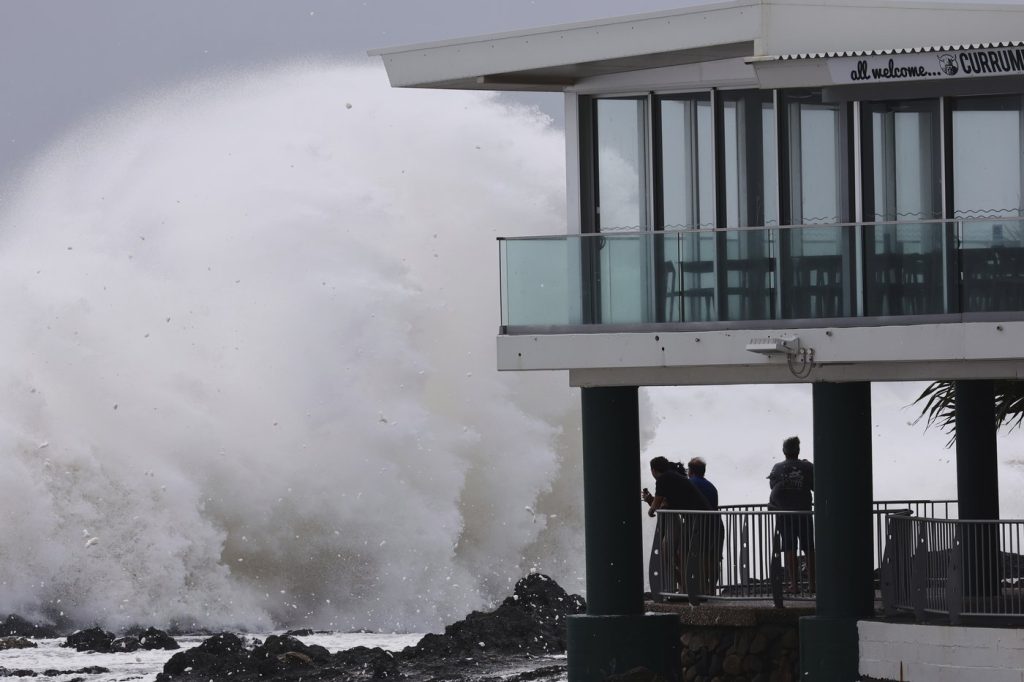BRISBANE, Australia (AP) – In a rare weather event for eastern Australia, early wind and rain from Tropical Cyclone Alfred began affecting the region on Thursday, prompting school closures, halting public transport, and causing residents to seek potting mix as an alternative to sandbags due to shortages.
According to Bureau of Meteorology manager Matt Collopy, Tropical Cyclone Alfred is expected to make landfall along the Queensland coast between the Sunshine Coast and the Gold Coast on Saturday. This path puts Brisbane, Australia's third-most populous city and future host of the 2032 Olympic Games, directly in its influence.
Collopy noted that wind impacts had already started to be felt, particularly in exposed coastal areas, where gusts were recorded between 80 and 90 kph (50 to 56 mph). He expressed concern regarding the storm's progression, stating, "We are expecting those to continue to develop." This cyclone is predicted to be the first cyclone to hit the Brisbane area since Cyclone Zoe in 1974, which resulted in extensive flooding.
Although cyclones are common in Queensland’s tropical north, they are unusual in the state's temperate southeast. Approximately 4 million people are at risk from this cyclone.
On Thursday, Cyclone Alfred was positioned 280 kilometers (170 miles) east of Brisbane with sustained winds near its center of 95 kph (59 mph) and gusts reaching up to 130 kph (81 mph), as reported by Collopy. While the cyclone is expected to maintain wind strength before landfall, significant flooding remains a primary concern. Projections suggest that up to 20,000 homes in flood-prone Brisbane could experience varying levels of inundation.
As the storm worsened, Prime Minister Anthony Albanese announced that 660 schools in southern Queensland and 280 schools in northern New South Wales would be closed. The federal government had dispatched 310,000 sandbags to Brisbane, with additional supplies on the way. "My message to people, whether they be in southeast Queensland or northern New South Wales, is we are there to support you. We have your back," Albanese stated to reporters in Canberra.
Due to a scarcity of sandbags, many residents resorted to purchasing potting mix as a stopgap measure. Damien Effeney, a rural supplies business CEO, indicated that the ease of obtaining potting mix influenced consumers, as they faced long lines and limited supply for sandbags. One individual reportedly bought 30 bags of potting mix amid the crisis. Several collection points for sandbags were reported to be empty, and some residents even reported theft of sand for filling bags.
The effects of the cyclone were visible throughout Brisbane, with streets nearly devoid of traffic and supermarket shelves stripped of essentials like bread, milk, bottled water, and batteries. Public transport systems in affected areas were suspended as hospitals limited services to emergency surgeries only.
As of Thursday, strong winds had resulted in power outages impacting around 4,500 homes and businesses in northern New South Wales. Rivers in the region began to rise due to ongoing rain, prompting emergency teams to prepare for evacuations in low-lying areas near the state border. The coastal region had already been experiencing severe conditions, with a record-breaking wave of 12.3 meters (40 feet) tall recorded off a popular Gold Coast beach on Wednesday.
Residents in the cyclone's path received an unexpected additional 24 hours to prepare as forecasters updated their expectations for landfall from Thursday night to Saturday. However, this slowed progress toward the coast brought concerns about prolonged periods of rainfall and wind, raising fears of substantial damage.










